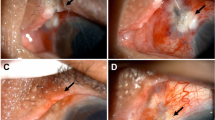Abstract
Purpose
The purpose of this study was to investigate the thermal injuries caused by ultrasonic pars plana phacoemulsification and aspiration (PPPEA) using pig eyes.
Method
Using a 20-gauge (G) vitrectomy system (Accurus®, Fragmatome; Alcon Laboratories) in both the ‘open-tip’ and ‘closed-tip’ techniques, PPPEA was performed in pig eyes and the subsequent thermal injuries generated around the scleral wound were measured by infrared thermal imaging (thermography). Post surgery, the state of the scleral wound was observed under a microscope, and a tissue slice containing the scleral wound was then prepared and observed under an optical microscope.
Results
Thermography measurements revealed a slight temperature rise around the scleral wound in the open-tip case, yet a marked temperature rise in the closed-tip case. The scleral wound incision produced by the open tip was linear, while that produced by the closed tip was expanded. Histological examination revealed mild degeneration of the sclera around the wound in the open-tip case, yet marked tissue degeneration by thermal injuries in the closed-tip case.
Conclusion
Our findings showed that in PPPEA, the temperature of the tip of a 20G vitrectomy system rapidly increases due to the closed-tip technique, thus producing obvious thermal damage to the scleral wound. In order to prevent thermal injuries to the scleral wound during PPPEA, it is important to shorten the time of ultrasonic oscillation during surgery as much as possible while the tip is occluded with nuclear fragments.




Similar content being viewed by others
References
Spirn MJ (2009) Comparison of 25, 23 and 20-gauge vitrectomy. Curr Opin Ophthalmol 20(3):195–199
von Lany H, Mahmood S, James CR, Cole MD, Charles SJ, Foot B, Gouws P, Shaw S (2008) Displacement of nuclear fragments into the vitreous complicating phacoemulsification surgery in the UK: clinical features, outcomes and management. Br J Ophthalmol 92(4):493–495
Ernest P, Rhem M, McDermott M, Lavery K, Sensoli A (2001) Phacoemulsification conditions resulting in thermal wound injury. J Cataract Refract Surg 27(11):1829–1839
Sippel KC, Pineda R Jr (2002) Phacoemulsification and thermal wound injury. Semin Ophthalmol 17(3–4):102–109
Bissen-Miyajima H, Shimmura S, Tsubota K (1999) Thermal effect on corneal incisions with different phacoemulsification ultrasonic tips. J Cataract Refract Surg 25(1):60–64
Bradley MJ, Olson RJ (2006) A survey about phacoemulsification incision thermal contraction incidence and causal relationships. Am J Ophthalmol 141(1):222–224
Chang B, O’Reilly P, Tormey P (2002) Thermal injury in phacoemulsification: a survey of eye surgeons in Ireland. J Cataract Refract Surg 28(11):2061–2062
Fujiwara Y, Inukai T, Aso Y, Takemura Y (2000) Thermographic measurement of skin temperature recovery time of extremities in patients with type 2 diabetes mellitus. Exp Clin Endocrinol Diabetes 108(7):463469
Sigler EJ, Calzada JI (2014) 25-gauge pars plana lensectomy with vitrectomy. Ophthalmic Surg Lasers Imaging Retina 45(6):570–572
Bhandari R, Ernst BJ, Stafeeva K, Mandava N, Quiroz-Mercado H (2012) 23-gauge vitrectomy for retained lens material. Ophthalmic Surg Lasers Imaging 43(4):351–352
Kongsap P (2010) Combined 20-gauge and 23-gauge pars plana vitrectomy for the management of posteriorly dislocated lens: a case series. Clin Ophthalmol 21(4):625–628
Cho M, Chan RP (2011) 23-gauge pars plana vitrectomy for management of posteriorly dislocated crystalline lens. Clin Ophthalmol 5:1737–1743
Koh KM, Kim HS, Cho HJ, Lew YJ, Choi MJ, Han JI, Cho SW, Kim CG, Lee TG, Kim JW, Yoo SJ (2014) Surgical outcomes of 23-gauge vitrectomy for the management of lens fragments dropped into the vitreous cavity during cataract surgery. Saudi J Ophthalmol 28(4):253–256
Takkar B, Azad R, Azad S, Rathi A (2015) Posterior segment nucleotomy for dislocated sclerotic cataractous lens using chandelier endoilluminator and sharp tipped chopper. Int J Ophthalmol 8(4):833–834
Nagpal M, Jain P (2014) Dropped lens fragment, dislocated intraocular lens. Dev Ophthalmol 54:234–242
Tzamalis A, Symeonidis C, Brazitikou IP, Tzetzi D, Chalvatzis N, Androudi S, Brazitikos P (2017) Sutureless clear corneal ultrasonic fragmentation for retained lens fragments: a Pilot Study. Retina 37(3):494–499
Nakasato H, Uemoto R, Kawagoe T, Okada E, Mizuki N (2012) Immediate removal of posteriorly dislocated lens fragments through sclerocorneal incision during cataract surgery. Br J Ophthalmol 96(8):1058–1062
Kumar V, Takkar B (2016) Intravitreal phacoemulsification using torsional handpiece for retained lens fragments. J Ophthalmic Vis Res 11(3):268–270
Simpanya MF, Ansari RR, Suh KI, Leverenz VR, Giblin FJ (2005) Aggregation of lens crystallins in an in vivo hyperbaric oxygen guinea pig model of nuclear cataract: dynamic light-scattering and HPLC analysis. Invest Ophthalmol Vis Sci 46(12):4641–4651
Tsuneoka H, Shiba T, Takahashi Y (2002) Ultrasonic phacoemulsification using a 1.4 mm incision: clinical results. J Cataract Refract Surg 28(1):81–86
Tsuneoka H, Shiba T, Takahashi Y (2001) Feasibility of ultrasound cataract surgery with a 1.4 mm incision. J Cataract Refract Surg 27(6):934–940
Acknowledgements
The authors wish to thank John Bush for editing the manuscript.
Author information
Authors and Affiliations
Corresponding author
Ethics declarations
Conflict of interest
The authors declare that they have conflicts of interest.
Ethical approval
This article does not contain any studies with human participants and animals performed by any of the authors.
Rights and permissions
About this article
Cite this article
Sato, T., Yasuhara, T., Fukumoto, M. et al. Investigation of scleral thermal injuries caused by ultrasonic pars plana phacoemulsification and aspiration using pig eyes. Int Ophthalmol 39, 2015–2021 (2019). https://doi.org/10.1007/s10792-018-1036-6
Received:
Accepted:
Published:
Issue Date:
DOI: https://doi.org/10.1007/s10792-018-1036-6




